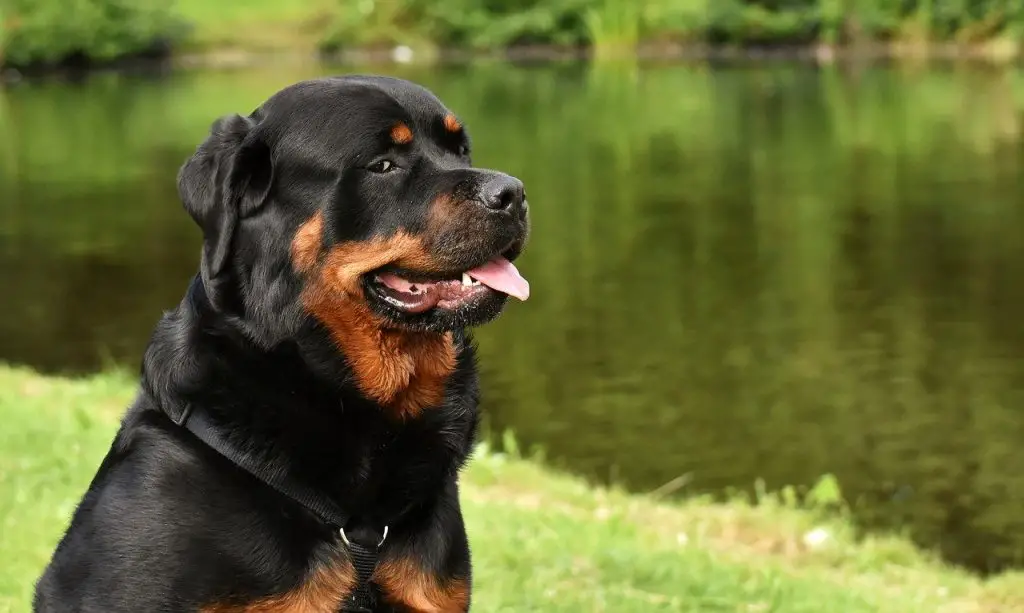Overview
Group: Working Group
AKC Breed Popularity Rank: No. 8 of 195
Height: Male – 24-27 inches; Female – 22-25 inches
Weight: Male – 95-135 lbs; Female – 80-100 lbs
Life Span: 9-10 years
Temperament: Loyal; Fiercely Confident and Protective Guardian; Loving
It is most unfortunate that Rottweilers have developed a reputation for being a mean, vicious dog, almost akin to the bad publicity being accorded to Pitbulls. However, Rotties would never have reached No. 8 in the AKC Breed Popularity Ranking if it were truly a “bad dog”. In fact, the REAL Rottweiler is a gentle dog and stalwart guardian of the family.
History
During the worldwide expansion of the Roman Empire, they brought their dogs with them to guard their herds. These dogs were bred with Asian and/or Italian Mastiffs, resulting in the distant ancestors of the Rottweiler. When the Romans battled the Germanic tribes, their dogs became the breeding stock for the existing German breeds.
Upon the collapse of the Empire, these dogs became cattle drovers, herd protectors, and bandit fighters in the town of Rottweil, from which their present name originated.
Presently, Rottweilers have excelled as guard and police dogs, as well as assisted in blue-collar labor. Rotties were also among the first breeds to serve as guide dogs for the blind. Among the 300 dogs deployed for search and rescue in the aftermath of the Oklahoma City bombing and 9/11 were Rottweilers.
One famous Rottweiler who gained worldwide attention is two-year old Jake who saved a woman from sexual assault in Hearsall Common, Coventry, England. Jake was awarded the bravery medallion by the RSPCA.
General Appearance
The Rottweiler is a robust, muscular, medium large dog. Its compact build evokes great strength, endurance, and agility. Its coat is short, smooth, and shiny, mostly black in color with tan or rust markings. The Rottie has a broad head with a deep muzzle and small drop ears. Its chest is broad and deep.
The AKC describes the breed standard for the Rottweiler’s temperament as “calm, confident, and courageous…with a self-assured aloofness” with the Kennel Club of the United Kingdom adding that the breed should be “good natured, not nervous, aggressive or vicious.”
Simply put, while a Rottie may look aloof, it should not be misconstrued as a sign of aggressiveness. Rottweilers are innate assessors of their environment, responding quietly to what is going on around it before acting. But once you gain their trust, they are adorable, goofy playmates that love to cuddle, despite their size.
Nutrition
Because of their size and energy levels, adult Rotties need 22 to 26% protein in their diet. The best protein sources include chicken, lamb, turkey, and herring. Some breeders recommend giving Rottweiler puppies adult food in order to prevent rapid growth which may lead to joint problems in adulthood. While treats are great aids in training, they should be given in moderation to prevent overweightedness and obesity.
Grooming
Rottweilers are very easy to groom because of their short coats. It is sufficient to brush your dog weekly with a firm bristle brush to remove dead or excess hairs. Only bathe the dog when necessary. If you bathe your dog too often, you will wash away the natural oils that give its coat its gloss. Also, it may cause drying of the skin, which may lead to skin irritation. If your dog gets dirty often, you may want to consider using a dry shampoo.
Exercise
It is important to give your Rottweiler daily exercise in the form of walking, jogging/trotting, or swimming. Make your dog your partner in your exercise routine since they love nothing more than to play and simply be with you. If you happen to live in the country, have your Rottweiler assist you in tracking and herding activities.
Training
As early as puppyhood, the Rottweiler needs to go through basic training and socialization classes. If it is to be a family dog, your Rottie needs to be living at home and exposed to family members and their daily routines, as well as frequent visitors. Socialization is especially important because of the breed’s territorial tendencies. They should be trained so that they don’t perceive strangers as threats. Trainers warn Rottie owners not to indulge in roughhousing with their dogs as this will encourage their aggressive tendencies. They also advise that owners identify triggers for aggression and practice negative punishment to curb these tendencies.
Health
Because of their heavy bulk, Rottweilers are prone to joint problems. That is why it is important for owners to maintain their weight. Rotties are also prone to allergies. Switch dog foods if they develop allergies as a result of certain ingredients. Aside from allergies, Rottweilers are at risk of developing colitis and canine inflammatory bowel disease. It is necessary to reduce their carbohydrate intake or increase raw foods in their diet. Rottweilers may also develop cancer. Veterinarians advise that owners carefully observe their dog’s vaccination schedule to lower cancer risk.
Costs
The average cost of a Rottweiler puppy is $1,000. But pups from championship lines may range from $2,500 to $9,000. Because of their health concerns, potential healthcare costs may average $7,800.
Don’t let bad publicity deter you from getting a Rottweiler for a pet. Despite their rather aloof demeanor, they are fiercely loyal and loving pets that will watch over your family.
SOURCES:
1) Rottweiler https://www.akc.org/dog-breeds/rottweiler/
2) Rottweiler honoured for stopping Coventry sex attacker https://www.bbc.com/news/uk-england-11413740
3) Are Rottweiler’s Dangerous? https://pets.thenest.com/rottweilers-dangerous-5675.html
4) Rottweiler Diet and Allergies https://www.petcarerx.com/article/rottweiler-diet-and-allergies/492
5) How to Deal with Aggression in Rottweilers https://pets.thenest.com/deal-aggression-rottweilers-6197.html
6) Rottweiler Puppies for Sale https://www.nextdaypets.com/Rottweiler.htm
7) Most Expensive Dog Breeds https://www.gobankingrates.com/saving-money/pets/most-expensive-dog-breeds/


